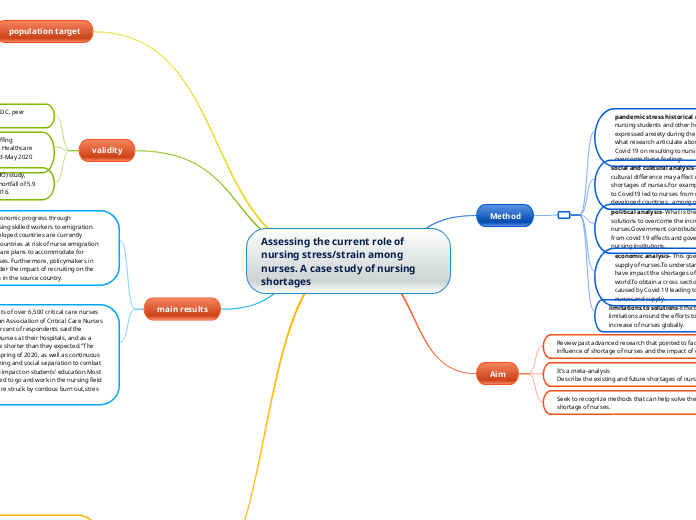Assessing the current role of nursing stress/strain among nurses. A case study of nursing shortages
Method
pandemic stress historical research-According to study, nursing students and other healthcare professionals expressed anxiety during the COVID-19 pandemic.To find out what research articulate about impacts of pandemics such as Covid 19 on resulting to nursing shortages.How nurses can overcome these feelings.
social and cuktural analysis-To assess how social and cultural difference may affect nurses and contribue to shortages of nurses.For example how demand od nurses due to Covid19 led to nurses from developing countries migrate to developed countries, among others.
political analysis- What is the role of politics in providing solutions to overcome the increase of the shortages of nurses.Government contributions to help nurses suffering from covid 19 effects and government cooperation with nursing institutions.
economic analysis- This goes to an assement of demand and supply of nurses.To understand how the demand of nurses have impact the shortages of nurses in different parts of the world.To obtain a cross sectional study on the economic impact caused by Covid 19 leading to the intense shortages of nursesand supply.
limitations to solutions-Effective assessmnet of the limitations around the efforts to take care of the intense increase of nurses globally.
Aim
Review past advanced research that pointed to factors that influence of shortage of nurses and the impact of covid.
It’s a meta-analysis
Describe the existing and future shortages of nurses.
Seek to recognize methods that can help solve the issue of the shortage of nurses.
population target
Graduate nurses with 1 or 2 years
Experienced and retiring health care workers and nurses
Other health proffessionals who work hand in hand with nurse like doctors, social workers etc.
validity
The authors used advanced researches, WHO ,CDC, peer reviewed journal articles,
Use of worldwide statics, uses federal data on staffing reported weekly by facilities to the CDC’s National Healthcare Safety Network (NHSN) and reflects data from mid-May 2020 through 2022
According to the World Health Organization's (WHO) study, State of the World's Nursing, there was a global shortfall of 5.9 million nurses in 2018, down from 6.6 million in 2016.
main results
Poor countries seeking economic progress through international trade risk losing skilled workers to emigration. Nursing shortages in developed countries are currently exacerbating this trend. Countries at risk of nurse emigration should alter their health-care plans to accommodate for anticipated workforce losses. Furthermore, policymakers in host nations should consider the impact of recruiting on the delivery of health services in the source country.
According to a study results of over 6,500 critical care nurses conducted by the American Association of Critical Care Nurses in September 2021, 92 percent of respondents said the pandemic had "depleted nurses at their hospitals, and as a result, their careers will be shorter than they expected."The nation's shutdown in the spring of 2020, as well as continuous measures of remote learning and social separation to combat the virus's spread, had an impact on students' education.Most students were not prepared to go and work in the nursing field and those that made it were struck by contious burn out,stres and turn over.
To close this critical gap, ICN urges governments to protect the safety and wellbeing of nurses,
provide adequate psychosocial support in light of the traumas they face, and commit to long-term strategies to
increase the global stock of nursing workforce. Sustained investment in the training,
recruitment and retention of nurses is crucial to meet the needs during the current pandemic and future needs of the population, as are
fair pay, decent work and an attractive career structure.
appraisal
English reports of nurses intending to leave their jobs or the profession were carefully identified using an electronic database. The most important findings and issues were summarized. The findings in measurement devices, samples, and levels of desire to leave made it impossible to compare and synthesize results. Nurses' influencing factors were found and categorize into organizational and individual elements.
The articles give information that can be used to develop and implement strategies for maintaining a stable nursing workforce.
The authors suggest that the reasons for the nurse shortage are complex, and that there is no single global or local indicator of its severity. Ineffective planning and use of limited nursing resources, poor rectuitement or an undersupply of new staff, and global demorgraphic conditions are all signs of the problem. Nursing shortages have reached a critical point for both local and worldwide healthcare systems, according to the summary, and pandemic stress has exacerbated the problem.
